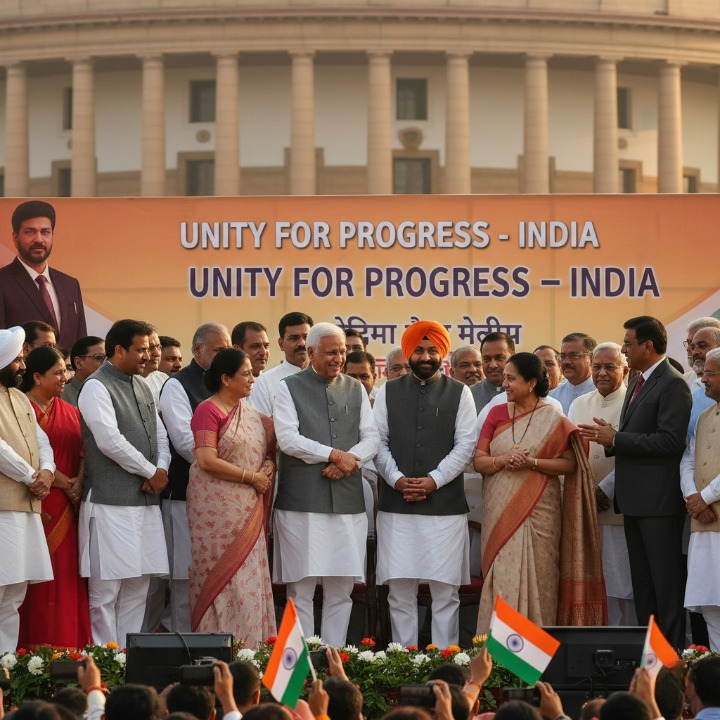Key Metrics:
- Lok Sabha Seats: 80
- Rajya Sabha Seats: 31
- Population: Over 220 million (2025 estimate)
- Area: 243,286 square kilometers
- Rural Population: Approximately 77%
Lucknow, 2025 — Uttar Pradesh (UP), India’s most populous state, holds a pivotal role in shaping the nation’s political future. With its unique blend of diversity, historical significance, and sheer electoral weight, UP has long served as a crucible for political leadership and transformative change. This article explores how the state’s political landscape continues to influence leadership at the national level and drive change across India’s democratic fabric.
Leadership Nursery for National Politics
- Prime Ministers and Political Icons
- Historical Significance: UP has produced several of India’s Prime Ministers, including Jawaharlal Nehru, Indira Gandhi, and Atal Bihari Vajpayee, who left indelible marks on the nation’s governance and policies.
- Contemporary Leaders: Current political stalwarts, including Narendra Modi (who contested from Varanasi), continue to draw strength from UP’s vibrant political ecosystem.
- Testing Ground for New Leadership
- Grassroots Mobilization: UP’s diverse demographic challenges provide a robust testing ground for aspiring leaders to develop skills in coalition-building, negotiation, and governance.
- Emerging Youth Leaders: The rise of young and dynamic leaders reflects a generational shift, emphasizing innovation and issue-based politics.
Catalyst for Policy Innovation
- Policy Piloting
- Developmental Models: Nationally significant policies, such as rural employment schemes and digital governance initiatives, are often first piloted in UP due to its representative demographic.
- Social Welfare Programs: Flagship programs like Ayushman Bharat and the Pradhan Mantri Awas Yojana have seen extensive implementation in UP, shaping their eventual rollout across the country.
- Electoral Experimentation
- Coalition Dynamics: The state’s multi-party environment serves as a laboratory for coalition strategies, influencing national politics and providing insights into voter behavior.
- Campaign Innovations: UP has pioneered digital and grassroots campaigning methods, setting trends that are later adopted nationally.
Drivers of Change
- Demographic and Social Shifts
- Urbanization: Rapid urban growth in cities like Lucknow and Noida has led to changing voter priorities, from rural issues to urban development and job creation.
- Youth and Women: The increasing political participation of youth and women is reshaping UP’s political discourse, emphasizing education, employment, and gender equality.
- Caste and Religion
- Caste Dynamics: While caste-based politics remain influential, there is a gradual shift towards development-oriented politics that aim to transcend traditional divides.
- Religious Significance: The presence of major religious sites like Ayodhya and Varanasi places UP at the center of debates on communal harmony and cultural policies.
Challenges in Leading Change
- Economic and Developmental Gaps
- Rural-Urban Divide: While urban centers are thriving, rural areas often lag in infrastructure, education, and healthcare, posing challenges for inclusive growth.
- Unemployment: Addressing youth unemployment remains a critical issue, with political parties focusing on industrialization and skill development as solutions.
- Political Volatility
- Frequent Power Shifts: UP’s electorate is known for its volatility, leading to frequent changes in government, which can disrupt policy continuity.
- Communal Tensions: Managing communal harmony amidst periodic tensions requires strong, visionary leadership.
Conclusion: A Beacon for India’s Future
Uttar Pradesh’s political landscape, marked by its diversity and dynamism, continues to shape the national narrative. As a crucible for leadership and change, the state is a microcosm of India’s democratic spirit, reflecting its challenges and triumphs. By fostering inclusive development and empowering its citizens, UP holds the potential to lead India into a new era of progress and stability.


Leave a Reply